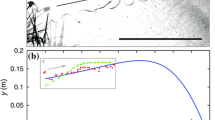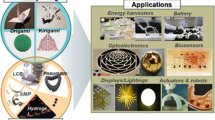Abstract
The design of physical interfaces has been constrained by the relative akinesis of the material world. Current advances in materials science promise to change this. In this paper, we present a foundation for the design of shape-changing surfaces in human–computer interaction. We provide a survey of shape-changing materials and their primary dynamic properties, define the concept of soft mechanics within an HCI context, and describe a soft mechanical alphabet that provides the kinetic foundation for the design of four design probes: Surflex, SpeakCup, Sprout I/O, and Shutters. These probes explore how individual soft mechanical elements can be combined to create large-scale transformable surfaces, which can alter their topology, texture, and permeability. We conclude by providing application themes for shape-changing materials in HCI and directions for future work.














Similar content being viewed by others
References
Berzowska J, Coelho M (2005) Kukkia and vilkas: kinetic electronic garments. In: The proceedings of the symposium on wearable computers (ISWC’05). IEEE, pp 82–85
Cassinelli A et al (2005) Khronos projector. In: Extended proceedings of SIGGRAPH
Coelho M (2007) Programming the material world: a proposition for the application and design of transitive materials. The 9th international conference on ubiquitous computing (Ubicomp ‘07), Innsbruck, Austria
Coelho M, Maes P (2008) Sprout I/O: a texturally rich interface. In: The proceedings of tangible and embedded interaction (TEI’08). ACM Press, Bonn
Coelho M, Ishii H, Maes P (2008) Surflex: a programmable surface for the design of tangible interfaces. In: The extended abstracts of conference on human factors in computing systems (CHI ‘08). ACM, Florence
Coelho M, Maes P (2009) Shutters: a permeable surface for environmental control and communication. In the 3rd tangible and embedded interaction conference (TEI ‘09). Cambridge, UK: ACM Press
Fan J-N, Schodek D (2007) Personalized furniture within the condition of mass production. The 9th international conference on ubiquitous computing (Ubicomp ‘07). Innsbruck, Austria
Goulthorpe M (2000) Hyposurface. From http://hyposurface.org/. Retrieved 30 Aug 2008
Strandh S (1988) Christopher polhem and his mechanical alphabet. Tech cult 10:143–168
Hutchins EL et al (1986) Direct manipulation interfaces. In user centered system design. Lawrence, Erlbaum
Interrante V, Fuchs H, Pizer SM (1997) Conveying the 3D shape of smoothly curving transparent surfaces via texture. IEEE Trans Vis Comput Graph 3:98–117
Lynn G (1999) Animate form: a book & interactive CD-ROM. Architectural Press, Princeton
Michelitsch G, Williams J, Osen M, Jimenez B, Rapp S (2004) Haptic chameleon: a new concept of shape-changing user interface controls with force feedback. In: The extended abstracts on human factors in computing systems (CHI ‘04). ACM Press, Vienna, pp 1305–1308
Norman D (1990) The design of everyday things. Doubleday/Currency, New York
Poupyrev I, Nashida T, Okabe M (2007) Actuation and tangible user interfaces: the vaucanson duck, robots, and shape displays. In: Proceedings of TEI’07. ACM, pp 205–212
Raffle H, Ishii H, Tichenor J (2004) Super cilia skin: a textural membrane. Text J Cloth Culture 2(3):328–347
Raffle HS, Parkes AJ, Ishii H (2004) Topobo: a constructive assembly system with kinetic memory. In: Proceedings of the SIGCHI conference on human factors in computing systems. ACM Press, Vienna, pp 647–654
Taylor M (2003) Surface consciousness: surface-talk. Architectural design, p 73
Thompson D (1992) On growth and form. In: Bonner JT (ed) Cambridge University Press, Cambridge, UK
Trimmer BA, Takesian AE, Sweet BM, Rogers CB, Hake DC, Rogers DJ (2006) Caterpillar locomotion: a new model for soft-bodied climbing and burrowing robots. In: The 7th international symposium on technology and the mine problem. Mine Warfare Association, Monterey, CA
Zigelbaum J, Chang A, Gouldstone J, Monzen JJ, Ishii, H (2008) SpeakCup: simplicity, BABL, and shape change. In: The proceedings of the second international conference on tangible and embedded interaction (TEI’08). Bonn, German
Acknowledgments
We would like to thank everybody who in some way or another helped with this work. Specifically, we would like to acknowledge the work of Analisa Russo, Elly Jessop, Josh Kopin, Katie Puckett, and Najiyah Edun in helping physically build the prototypes described here; Pattie Maes for the intellectual support and inspiration; the Fluid Interfaces Group at the MIT Media Lab for the innumerous suggestions on how to improve this work; and finally Joanna Berzowska, Kent Larson, Mette Thomsen, and Steve Helsing for all of their initial suggestions, collaborations, and providing some of the original sources of inspiration for this work.
Author information
Authors and Affiliations
Corresponding author
Rights and permissions
About this article
Cite this article
Coelho, M., Zigelbaum, J. Shape-changing interfaces. Pers Ubiquit Comput 15, 161–173 (2011). https://doi.org/10.1007/s00779-010-0311-y
Received:
Accepted:
Published:
Issue Date:
DOI: https://doi.org/10.1007/s00779-010-0311-y




